Questions and Answers
Over the course of the development and construction of Rampion Offshore Wind Farm, we have had hundreds of questions so we have selected the most common to be answered on this page
Over the course of the development and construction of Rampion Offshore Wind Farm, we have had hundreds of questions so we have selected the most common to be answered on this page
The offshore wind farm site is located in the English Channel, off the Sussex coast and extends from approximately 13km to 20km offshore, occupying an irregular elongated area, approximately 19km in an east to west direction and approximately 7km in the north to south direction. The site has an overall area of 72km2, reduced from the consented area of 122km2, which in turn was reduced from 167km2 following refinements to the scheme during the consultation and examination process. These refinements were designed to reduce the visual impact from the Heritage Coast, minimise deviation for vessels using the local route from the Traffic Separation Scheme to Shoreham Port and to reduce the impact on commercial fishing.
The project management facility for construction is located at Newhaven Port. This is due to portside availability, flexibility of space and ease of access to the Rampion site. However, the port also offers continuity throughout construction and into operation as the operations and maintenance base will also be at Newhaven Port.
For safety reasons, during construction there would be a 500-metre safety zone placed around the area under construction. The details of the safety zones have been notified to sea users throughout the construction. Once the wind farm is operational, most sea users will be able to continue commercial and recreational use of the sea area as before. However, a limited number of larger commercial vessels may choose not to navigate through the wind farm.
On average, there have been 250 to 300 people working on the offshore site, around 60 to 100 working on the onshore cable route split into teams working on separate sections, and 40-60 working on the onshore substation. The exact number of jobs created during construction has been influenced by the phasing of the roll-out of the scheme and will also be dependent on the lead construction contractors. At its peak period there were 550 people working offshore.
Around 60 full time jobs will be created at the project management facility in Newhaven Port and we will utilise locally sourced vessels for the 3-year construction period.
Once operational, Rampion will have around 60 full time, permanent roles based at the operations & maintenance base in Newhaven Port, to manage and maintain the site. In additional to the directly employed workforce, the operation of the wind farm will give rise to opportunities for indirect local employment in the form of up to 30 support service contracts and other local expenditure.
Around 60 full time jobs will be created at the project management facility in Newhaven Port and we will utilise locally sourced vessels for the 3-year construction period.
We continue to use local companies where possible in this project. In developing the project proposal a number of contracts were placed with local suppliers in respect of providing the met mast and installation, geotechnical site investigations, ecological survey vessels, guard boats, Fishing Industry Representatives, PR support, offshore ecology survey work, and E.ON’s own Rampion Development Manager has been sourced locally.
We worked in partnership with local authorities, forming a Supply Chain Steering Group to support a Supply Chain Project led by Marine South East (MSE). The work of the Steering Group was aimed at identifying the local supply chain and maximising opportunities for local companies who may be able to tender for Rampion work. This project identified more than 600 local businesses with the capability to supply products and services to Rampion, and culminated in Meet the Buyer Events and the launch of the web portal, www.sussexwindenergy.org.uk, which went live in September 2013 to provide Rampion Project updates, promote local grant programmes and opportunities for recruitment and skills development. The web portal allows local businesses to register their details on a suppliers’ database, to express an interest in supplying goods and services to Rampion and its contractors.
The local suppliers’ database is highlighted in the Invitation to Tender documents and contractors have been asked to identify any proposed UK and local suppliers in their tender responses.
In supporting local content for operations and maintenance related jobs, we place local job adverts, require the turbine manufacture to advertise locally to recruit technicians where possible, and have already recruited a number of apprentices into full time operations staff.
Around 60 full time jobs will be created at the project management facility in Newhaven Port and we will utilise locally sourced vessels for the 3-year construction period.
Our policy with regards to community benefits is to ensure that we are a good neighbour to the local community and our majority shareholder has a track record on existing offshore wind farms of working with communities and supporting local initiatives and projects. The exact geographical scope and distribution of such initiatives will be carefully considered in view of the spatial extent of the project and those communities most associated with the project. For example we have committed to a community benefit fund for the residents who live in close proximity to the proposed onshore substation, as the only permanent above ground structure on land.
We are currently finalising our wider community benefit fund which will be launched in late 2017.
At this stage it is our intention to have a Visitor Centre somewhere on the Sussex Coast to support the local tourist economy and increase awareness of the Rampion wind farm and education about offshore wind energy. The Scroby Sands Visitor Centre in Great Yarmouth has been a great success, attracting around 40,000 visitors each year.
The Rampion Visitor Centre will be located between the eastern and westernmost points of the site, with a clear view of the wind farm and in an area with high visitor footfall.
We estimate that the project could avoid the emission of almost 600,000 tonnes1 CO2 per year (587,000 tonnes), which would otherwise have been released through fossil fuelled power generation. We know this because electricity generation and demand is actively balanced, every minute of every day by National Grid, to ensure that supply and demand are always precisely matched. Since wind energy is accepted onto the grid as and when it generates, conventional generators are required to reduce their generation and in turn the amount of fuel and CO2 released. Therefore we can calculate how much CO2 would have been emitted from the fossil fuel generators displaced.
1 Every unit (kWh) of electricity produced by the wind displaces a unit of electricity, which would otherwise have been produced by a power station burning fossil fuel. This is a generally accepted fact used by many organisations including Government in their environmental calculations. Wind-generated electricity does not replace electricity from nuclear power stations because these operate at ‘base load’, that is they will be working for the whole time that they are available. The calculation is made using a static figure of 430g CO2/kWh representing the energy mix in the UK.
Guidelines for drone usage at or near Rampion Offshore Wind Farm
Safety is always the first issue to consider and it is the drone operators’ responsibility to comply with the Drone Code, as published by the Civil Aviation Authority (CAA).
Drones must be kept:-
1) at least 150 metres from working vessels and people at site, both offshore and onshore.
2) at least 50m from wind turbines and offshore substation
3) within sight of the operator
If the drone is being operated from a vessel, the vessel itself must stay out of the statutory 500m Safety Zone around construction activities on wind turbines and the offshore substation.
The drone operator will be held responsible for any incident or damage arising from failure to comply with the above.
In 2008, nine strategic zones were identified for what is known as ‘Round 3’, the third licensing round for offshore wind farms. The nine strategic zones were established following a ‘Strategic Environmental Assessment’, which essentially investigated technological, engineering and environmental issues. These included, for example, water depth, shipping lanes, marine ecology, seabed geology, and wind speed data, which when overlaid onto a chart of UK waters, led to the proposed zones.
Zone 6, the zone from within which the Rampion site was chosen, could not migrate further south due to the Traffic Separation Scheme – the English Channel shipping lane.
Instead of the smaller projects from Rounds 1 and 2, which were situated nearer to shore in shallower waters, Round 3 nominated far larger zones designed to accommodate larger wind farms that could benefit from the improved, proven technology following the success of the earlier projects. Larger wind farms offer economies of scale and have enabled the industry to bring the costs of offshore wind down considerably, while maximising the contribution the technology can make to securing UK energy supplies and tackling climate change
Zone 6, the zone from within which the Rampion site was chosen, could not migrate further south due to the Traffic Separation Scheme – the English Channel shipping lane.
E.ON, the developer who secured the licence for Zone 6 from The Crown Estate, conducted further, much more in depth investigations and analyses of the seabed geology, marine ecology, available turbine and foundation technology, grid availability, local stakeholder concerns and so on, in order to formulate draft proposals. Zone 6 is a very complex site from a bathymetry and geological perspective. When coupled with the technology available, stakeholder feedback and engineering and environmental surveys, the scheme was optimized to produce the final design.
Zone 6, the zone from within which the Rampion site was chosen, could not migrate further south due to the Traffic Separation Scheme – the English Channel shipping lane.
In Zone 6, the project evolved to become a single wind farm in the strategic zone and the smallest Round 3 wind farm around the UK, more on a par with a Round 2 project. There were several reasons for this including the fact that there is a cliff face underwater to the south of the final chosen site, as well as much deeper waters and paleochannels (old river beds with silt). The technology required to support turbines in waters up to 62 metres deep was not proven to a sufficient degree to give confidence to expand the design and is also likely that it would have been prohibitively expensive to extend the site.
Zone 6, the zone from within which the Rampion site was chosen, could not migrate further south due to the Traffic Separation Scheme – the English Channel shipping lane.
The year of 2012 was spent formally consulting the local community. This included the delivery of 390,000 flyers to households in Sussex, advertising in the local press and broadcast media, a poster and leaflet campaign, links to council and neighbourhood websites, a Facebook page, presentations to community groups and emails to 2,500 stakeholder organisations in Sussex. We held 14 public exhibitions with 4,500 people attending and 1,500 written responses, which all fed into the mix as the proposals were continually refined.
In 2013, there were 14 public hearings at the Brighton Centre where those who had commented on the draft plans could raise their concerns. Additional refinements were made in light of feedback received. For example the wind farm was moved further from the Heritage Coast that lies to its east, its boundary was also changed to avoid a popular fishing area known as the ‘9-miler’ and local routes from the TSS to and from Shoreham Port.
Following further site specific engineering surveys and in consideration of stakeholder feedback, the scheme was optimised with its final 116 turbine layout.
not migrate further south due to the Traffic Separation Scheme – the English Channel shipping lane.
The Secretary of State (the then Department of Energy and Climate Change) awarded and made the Rampion Offshore Wind Farm Order 2014 on 16 July 2014.
The Order is a Statutory Instrument (secondary legislation) that permits the construction and operation of the development, which includes the consented plans and associated requirements and conditions, similar to planning conditions, that must be adhered to during the pre-construction, construction, operation and decommissioning of Rampion.
The capital investment from development through to construction and commissioning is likely to be in region of £1bn – £1.2bn.
The Order provided us with the permission to construct the project, and incorporated the Marine Licences for the offshore works, and effectively negating the need to apply for other consents, as they were deemed to be incorporated into the Order, for example Scheduled Monument consents.
In addition, we applied separately for European Protected Species Licences with regards to works around Great Crested Newts and Marine Mammals and other more minor consents (such as, drainage), and to the Environment Agency for consents for those areas where we cross major watercourses.
The final wind farm area will feature 116 x 3.45MW turbines. This decision was largely driven by the findings of our geotechnical surveys to understand the seabed conditions, which turned out to be challenging in some areas of the site. In total the scheme will contribute 400MW of newly installed electrical capacity to the UK’s energy mix.
The turbine layout is a regular grid matrix with a minimum spacing between the turbines of at least 750 m and including one offshore substation. The final layout was signed off by the relevant statutory bodies.
The 400MW of installed electrical capacity will generate almost 1,400 gigawatt hours (GWh) of power output each year from a clean, renewable energy source. This is enough power to supply the equivalent of almost 350,000 UK homes each year for the lifetime of the projectar grid matrix with a minimum spacing between the turbines of at least 750 m and including one offshore substation. The final layout was signed off by the relevant statutory bodies.
The Order conditions and requirements are similar to conditions placed on a consented application under the Town & Country Planning Act 1991, in that they must be met by the developer and discharged by the Relevant Authority. In the case of Rampion, has produced a number of plans and documents to demonstrate how we will undertake the works, and ensure that impacts are minimised or mitigated. These conditions and Requirements need to be discharged by West Sussex County Council or the South Downs National Park Authority (onshore works) and the Marine Management Organisation (offshore works), and they will ensure that we are undertaking the works in accordance with the plans and methodologies which have been agreed. These plans relate to issues around highways, archaeology, Public Rights of Way and broader environmental considerations such as ecology, landscaping and construction noise management.
They were monopile foundations to support all the turbines in the final layout, with a jacket foundation being employed for the offshore substation.
The onshore cable route is defined by the DCO as a 40m corridor within which we are restricted to a 30m working width. The onshore surveys helped with refining the working width to avoid ecologically sensitive areas, such as mature trees, and in particularly sensitive areas (pinch points) we reduced the working width to 15m for short distances to reduce the impact on hedgerows.
The optimised scheme of 400MW has allowed us to reduce the number of circuits from four to two. However, did still require the haul road, topsoil and subsoil storage areas and we need to retain sufficient distance between the circuits to meet thermal conductivity requirements.
Content Courtesy of Rampion Offshore Wind Farm .https://www.rampionoffshore.com
The new Brighton Diver 3 fast ultra-stable 900hp catamaran with 360 degree viewing and heated inside cabin and proper toilet.
Before you book the slower –cheaper tours of the Rampion wind farm please check our reviews onFacebook and TripAdvisor
We are operating the trips from 15th April 2021
Important Notice! Covid 19 please read
The crew of Brighton Diver III aim to make your trip as comfortable and safe as possible.
Pack a picnic and climb aboard for a once in a lifetime opportunity to see Brighton’s famous Rampion Wind Farm being built.
Speed out to the site Aboard our 11m ultra stable 900HP Southboats fast cat catamaran the famous Brighton Diver 3, you will experience a panoramic view of England’s “South Coast Riviera” as you cruise 9 nautical miles in each direction.
Get up close and personal with the gigantic turbines standing 150m high and the jack up ships, whose hulls rise out of the water as they assemble each of the 116 windmills, till completion of Europe’s largest windmill farm in late fall 2017.
Enjoy the sea breeze as you float in between the enormous yet elegant windmills, and marvel at the epic scale of this landmark industrial project, as Skipper Paul gives a running commentary and your burning questions answered.
Tours last 2 – 3 hours depending on tides, and generally depart at 0900hrs, 1200hrs or 1500hrs on Saturdays and Sundays and some weekdays
Prices range between £45 and £50 pounds per person.
The larger your party, the cheaper the fare, so why not bring the whole family for a superb day out you will remember for many years to come.
Contact Brighton Diver for further details:
07901 822 375
The south coast’s first offshore wind farm
The Rampion Offshore Wind Farm comprises 116 wind turbines that each sit on top of a foundation fixed into the seabed.
With an installed capacity of 400 megawatts (MW), it will generate 1,400 gigawatt hours (GWh) of green power each year, equal to the amount used annually by around 350,000 UK homes1, or almost half the houses in Sussex. It will reduce CO2 emissions by nearly 600,000 tonnes a year.
The wind farm site covers 70 square kilometres, so it is larger than the island of Guernsey, and is located in the English Channel between 13 and 20 kilometres off the Sussex coast.
When complete in 2018, it will create around 60 full-time permanent jobs. Rampion will be operated and maintained from a purpose-built base at Newhaven Port, and is already acting as a catalyst for the regeneration of the port area.


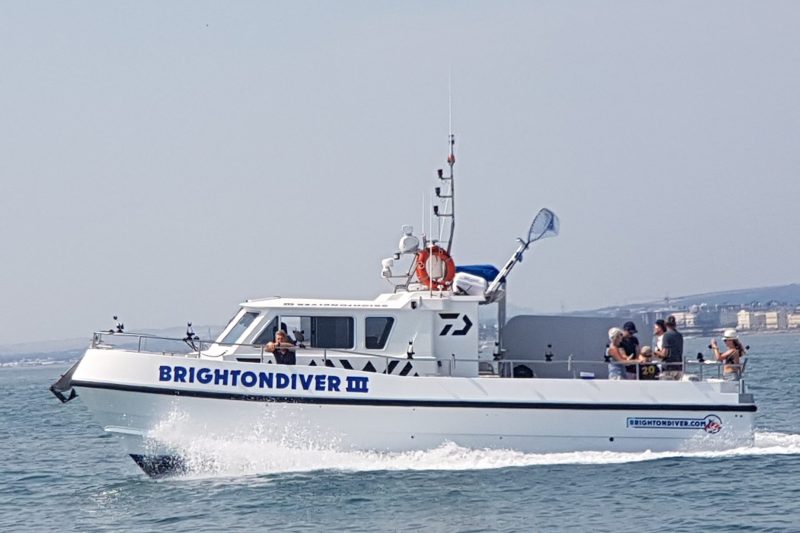
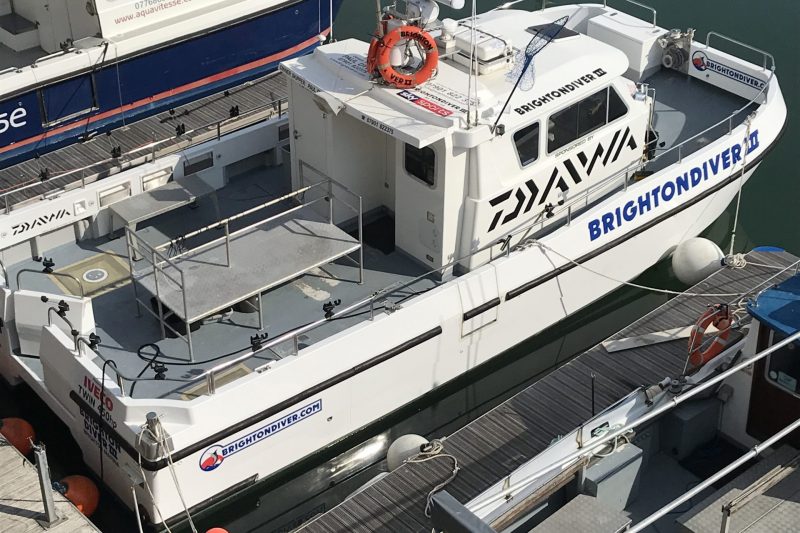
To Play in full HD quality click here
Please be patient as this is a very large file and will take a while to download
Offshore components
Rampion features 116 MHI Vestas 3.45 MW turbines. The turbines are made up of an 80 metre (m) tall tower, a nacelle for the generation equipment, a hub, and three 55m long blades. When vertical, the tip of the turbine blade reaches 140m, which is just taller than the Brighton i360’s viewing pod at its top height.
The turbines sit on top of foundations, comprising single steel monopiles and bright yellow transition pieces, designed so they integrate together perfectly. There are 12 rows of 10 to 12 turbines that are connected by array cables taking the power to a single offshore substation. A total of 140 kilometres of array cables are buried in a network under the seabed. Laid end to end, the array cables would stretch from Brighton to London and back.
The wind turbines generate power at 33 kilovolts (kV) and the main role of the offshore substation is to transform this up to 150kV, to reduce any losses as it is transmitted to shore. The 2,000 tonne structure houses the electrical components at the heart of the wind farm including transformers, switchgear and control systems. It sits on a four-leg jacket foundation, fixed into the seabed and weighing around 900 tonnes.
Electricity will be transmitted from the offshore substation along two 16km subsea export cables, which come to shore at the beach, next to Brooklands Pleasure Park in East Worthing.
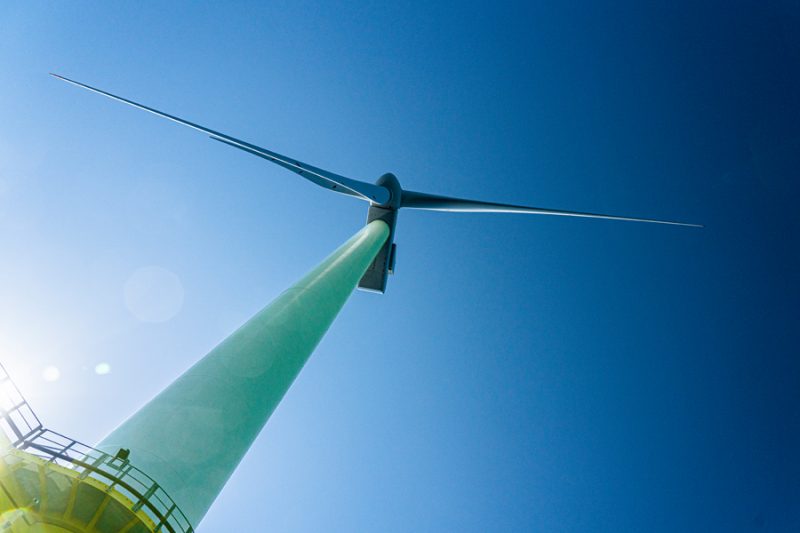
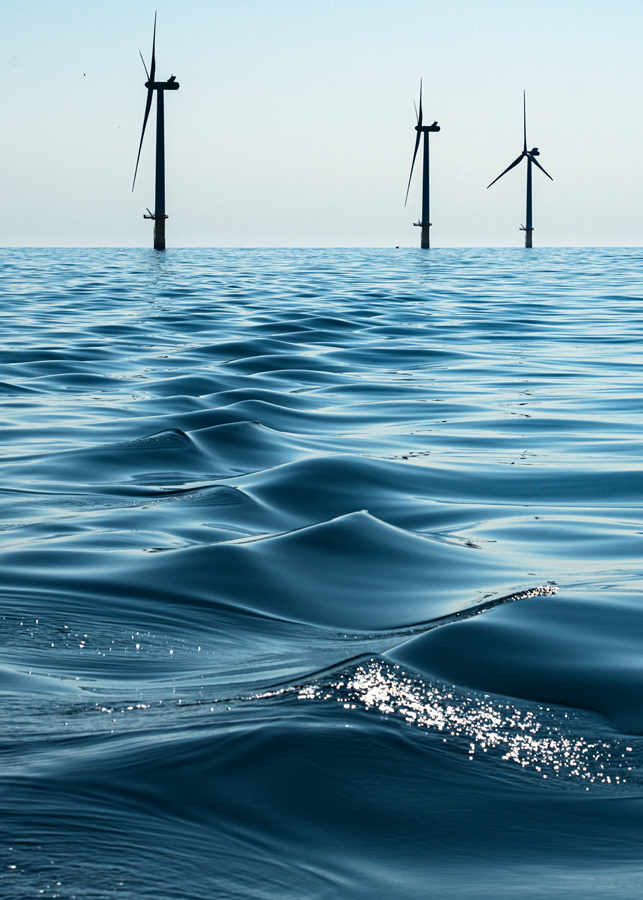
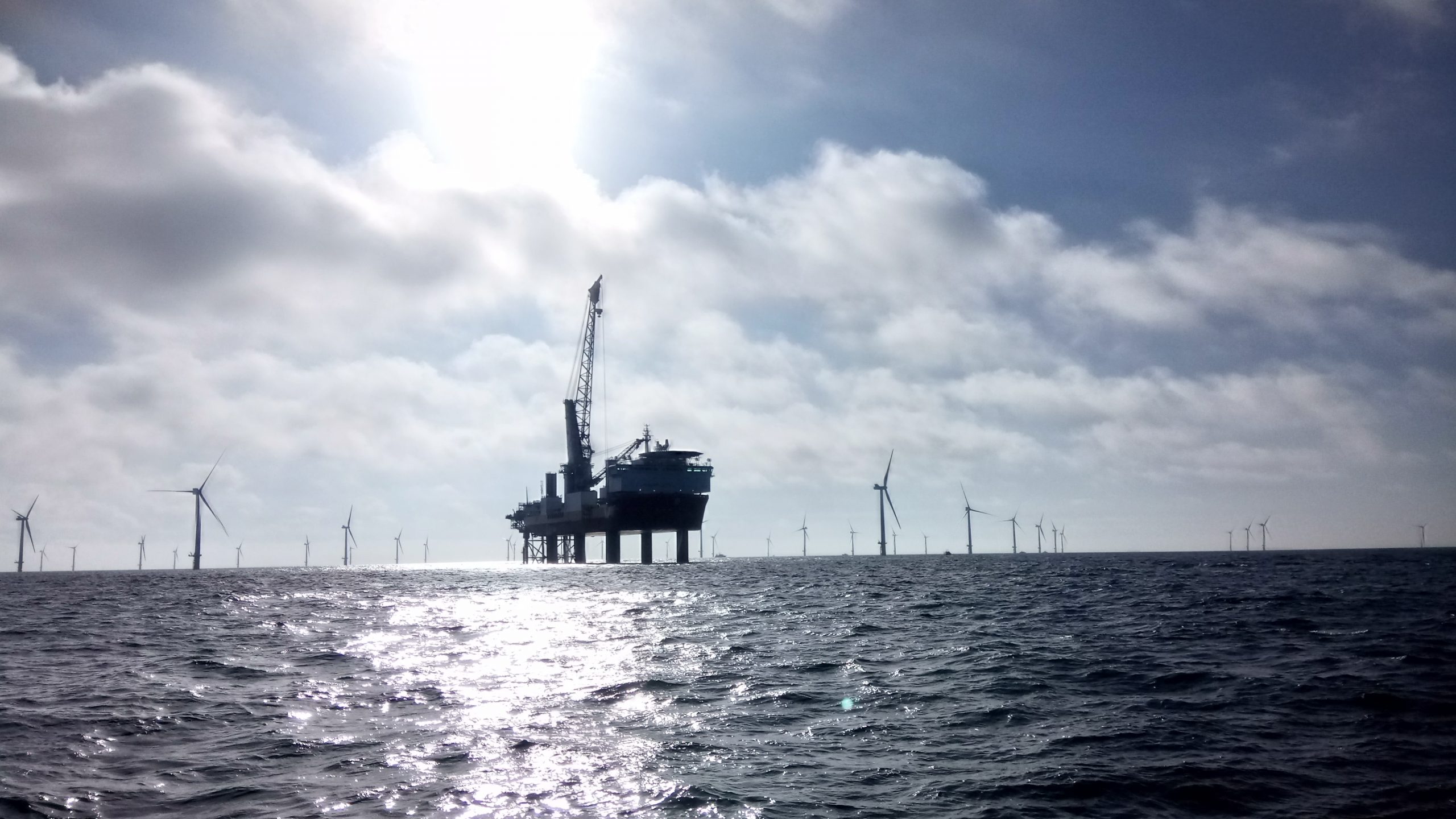
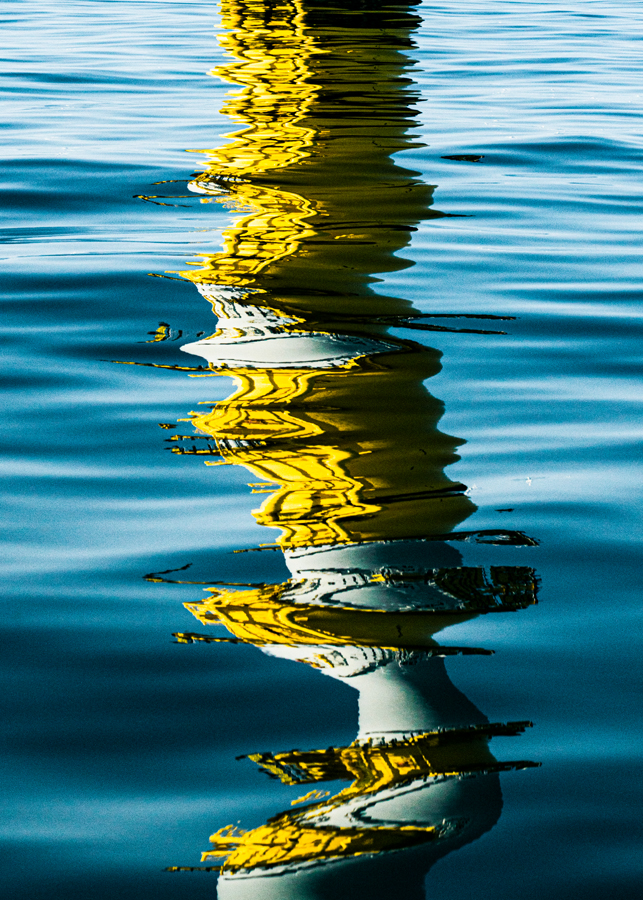
Next Rampion wind farm trips
August to October 2025
Next Rampion wind farm trips are below please call Paul if you would like to book 07901822375 email paul@brightondiver.com
Gift Vouchers
Available for 2025
Gift vouchers are the perfect way to communicate your cool gift to see this Green energy being produced up close.
Please email paul@brightondiver.com
Other dates available for private charters
If you don’t see your date it may be available please email,
2025
July
Wednesday 2nd ——-1200 depart—full
Saturday 5th —–depart 1200—-full
Sunday 6th —–depart 1200
Wednesday 9th —-0930 ——-1200 depart
Saturday 12th —–depart 1200
Sunday 13th —–0930 depart
Wednesday 16th —-0930 depart
Saturday 19th —–depart 1200—full
Sunday 20th —–0930 depart
Wednesday 23rd ——-0930 depart—full
Friday 25th ———1200 depart—full
Saturday 26th —–depart 1200—full
Sunday 27th —–depart 1200—–full
Wednesday 30th ——-1200 depart—-full
August
Friday 1st —-0930 depart—-full
Saturday 2nd —–depart 1200—full
Sunday 3rd —–0930 —–depart 1200
Monday 4th —–depart 0930 —–depart 1200
Saturday 9th —–depart 1200—full
Sunday 10th depart 1200—–full
Wednesday 13th —-0930 depart—-full
Thursday 14th —1200 depart—-full
Friday 15th —-1200 depart
Saturday 16th —–depart 1200—full
Sunday 17th —–1200 —–full
Wednesday 20th ——-1200 depart—-full
Thursday 21st —1200 depart—-full
Saturday 23rd —–depart 1200—full
Sunday 24th —–0930 depart —–full
Monday 25th bank holiday 0930 depart —1200 depart
Wednesday 27th —-0930 depart——-1200 depart
Saturday 30th —-depart 1200—-full
Sunday 31st —–0930 depart —–depart 1200
September
Wednesday 3rd —-0930 depart——-1200 depart
Friday 5th —–1200 depart
Saturday 6th —–depart 1200—–full
Sunday 7th —–depart 1200—x1 space
Wednesday 10th —-0930 depart——-1200 depart
Saturday 13th —-0930 depart—–depart 1200
Sunday 14th —–0930 depart —–depart 1200
Wednesday 17th —-0930 depart
Saturday 20th —–depart 1200
Sunday 21st —–0930 depart —–depart 1200
Wednesday 24th —-0930 depart——-1200 depart
Saturday 27th —–depart 1200
Sunday 28th —–0930 depart —–depart 1200
October
Saturday 11th —–depart 1200
Dates are subject to change. If you don’t see your date it may be available please email,
Other dates available for group bookings the trips need min x8 persons to go ahead.
Rampion Windfarm tour departs 0900 and 1200 1430 call Paul 07901822375 email paul@brightondiver.comBoat available Diving Fishing or Windfarm trip call Paul 07901822375 paul@brightondiver.com
Gift Vouchers
Available for 2024
Gift vouchers are the perfect way to communicate your cool gift to see this Green energy being produced up close.
Please email paul@brightondiver.com
From landfall, 27km of buried onshore cables will transport the power to a new onshore substation in Twineham, Mid Sussex. The cables have been installed in ducts laid in trenches that were backfilled prior to the cables being pulled through. A technique called horizontal directional drilling was used at four landmarks along the route – under the A27, the River Adur, railway line and, the A259 and Lancing Beach. By drilling under each of these, traffic and trains were not interrupted, the beach could remain open and environmental impact to the River Adur was minimised.
At the new substation, the electricity will be transformed from 150kV to 400kV and then transmitted to the existing National Grid substation. From here it will enter the national grid for use by homes, businesses and the wider community.
Construction time frame
Construction of the Rampion Offshore Wind Farm began in 2015 and is due to be fully operational in 2018, with the final completion date being largely dependent on logistics and weather during the construction period. Reinstatement of the onshore cable route will be monitored for 10 years and the wind farm itself will have a lifespan of 20 to 25 years.

